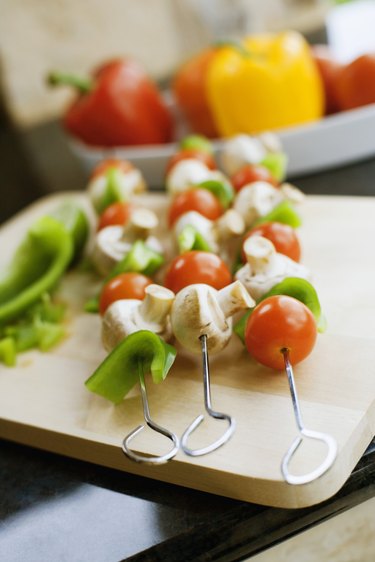Things You'll Need
Wood skewers
Food storage containers
Paper towels
Cutting board
Kitchen knife
Meat and vegetables
Seasonings and spices
Oil
2 baking dishes
Serving skewers (optional)

There are few reasons not to use a convection oven whenever possible. You might not think putting a fan in an oven would make that much of a difference, but it changes the dynamics of cooking by changing the way food responds to heat. Chemical changes occur more quickly, and Maillard reactions -- the processes that cause foods, especially meats, to caramelize and brown -- happen at a faster rate. You have to use multiple oven racks and space food adequately to get the most from convection cooking, especially when roasting a lot of individual pieces of food, such as skewered meat and vegetables for kabobs.
Step 1
Soak wood skewers in a container of water for about one hour before using them. Remove the skewers from the water and dab them with paper towels.
Video of the Day
Step 2
Cut vegetables into 1-by-1-inch pieces. You don't have to cut vegetables that are already close to that size, such as button mushrooms. The size of the vegetables doesn't matter as much as cutting them uniformly.
Step 3
Cut meat into 1-by-1-inch pieces. You don't have to cut shrimp or bay scallops, if using. The pieces will vary a bit, but cut as consistently as you can. Set the meat aside in food storage container if it will be a few minutes before you cook.
Step 4
Heat the oven to 325 degrees Fahrenheit with the convection fan on. Place the rack in the middle position.
Step 5
Thread the meat onto the wood skewers, spacing each piece 1/4 to 1/2 inch apart. Thread the vegetables onto the wood skewers, putting one piece of each type on each skewer. For example, if you have mushrooms, onions, peppers and tomatoes, put one piece of each on each skewer.
Step 6
Season the skewered foods to taste, rotating as you do so you get all sides. Place the skewers in separate, shallow baking dishes in a single layer.
Step 7
Place the skewers in the oven. Turn the kabobs over or rotate them by their skewers every 5 minutes.
Step 8
Roast beef skewers for about 5 minutes for medium. Tear a piece of meat open to check the doneness. Roast chicken for about 8 minutes. Roast fish and seafood 3 to 4 minutes, cooking just until the pieces turn opaque.
Step 9
Roast vegetable skewers about 15 to 20 minutes, depending on the type. If you use a lot of bell peppers, onions and mushrooms, you're looking at about 15 to 20 minutes. Tomatoes and vegetables with a lot of water take a bit less, around 12 to 15 minutes.
Step 10
Remove the dishes from the oven. If you are serving your kabobs off the skewers, slide the meat and vegetables onto a plate, bed of rice or other presentation.
Tip
Marinate the meat and vegetables in separate containers, if you use a marinade. You can marinate meat and vegetables for the same amount of time, about 1 to 2 hours. If marinating fish or seafood, marinate it for 5 to 10 minutes only. Lower the oven temperature by about 25 degrees when using a recipe made for a conventional oven. Use shallow dishes and baking pans if possible when using a convection oven.
Warning
To sanitize your tools after cutting chicken, wash and the knife and cutting board and then soak them in a solution of 1 part all-purpose bleach to 9 parts water for 15 minutes. Cut different meats separately. Never cut chicken, beef and/or fish on the same cutting board at the same time. Wash and sanitize the knife and cutting board before cutting vegetables if you cut meats with them previously. Use different skewers for different meats. Don't, for example, alternate beef and chicken on the same skewer.
Video of the Day